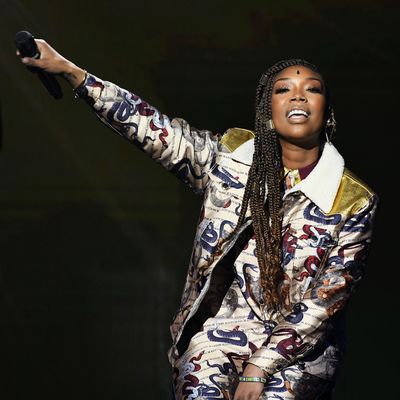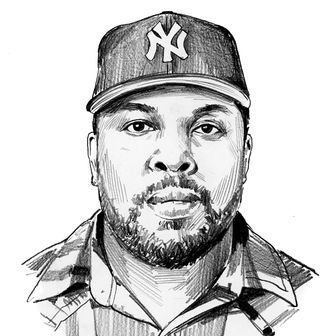
Brandy Norwood has had ups and downs in her nearly three decades as a singer-songwriter and producer; a television personality and film and stage actress; and a model and role model. Her television debut as Danesha, the smart and no-nonsense daughter of the titular character of comic Thea Vidale’s beloved if short-lived 1993 ABC sitcom Thea, set the pace for a decade spent raising the profile of Black girls and teens on television. Many Black shows featured a wise-cracking daughter or little sister — flash back to Regina King as Brenda Jenkins in 227 or Tempest Bledsoe and Raven-Symoné as Vanessa and Rudy Huxtable on The Cosby Show — but Brandy’s starring role in the 1996 UPN show Moesha, which made its long-overdue Netflix debut this month, centered her character’s struggles as a caring, considerate girl navigating high school, joining shows like Sister, Sister in giving Black girls the kind of dimensionality that, up until that point, had mostly been reserved for the boys.
Moesha was an overachiever, but she was far from perfect. She could be mean to friends. She could lose sight of what really mattered in her quest to excel at whatever endeavor she applied herself to. The show was a more down-to-earth portrayal of a Black American family than the Cosbys, Brooklyn brownstone owners with jazz legends for family friends (although, to be fair, it is never explained how Moesha knows Jodeci in “Million Boy March,” the season-one episode where she gets the North Carolina singing group to perform at a church fundraiser). Her dad and stepmom were stern, hard workers, but they sometimes screwed up. Set in the predominately Black southern California neighborhood of Leimert Park, Moesha depicted a more working-class Los Angeles than, say, The Fresh Prince of Bel-Air, whose mansion was walking distance from ranch land and the post-presidential home of Ronald and Nancy Reagan.
What was true of Brandy’s early acting exploits was also true of her music. Like Moesha, Brandy’s 1994 self-titled debut album added hip-hop flavor to wholesome emotional fare, balancing versatility with a very specific sense of time and place. The breakout single, “I Wanna Be Down,” is unmistakably a document of the West Coast G-funk era; “Baby” seems wise to future developments in hip-hop soul that tend to get credited to Mary J. Blige’s My Life and Faith Evans’s Faith, albums Brandy beat to the punch by several months. All this stuff lives on in samples; the Chance the Rapper and Shawn Mendes collaboration “Ballin Flossin” borrowed some of “I Wanna Be Down,” as did Burial’s “Fostercare.” Drake repurposed the album interlude “I Dedicate” for “Fire & Desire” off Views; Playa interpolated a bit of “Baby” in “I’ll B 2 C U.”
Where a less adventurous artist might stick with the winning team for the follow-up, Brandy took a chance on then up-and-coming producer Rodney “Darkchild” Jerkins, fresh off a string of placements on Mary’s Share My World album (including “I Can Love You” with Lil’ Kim). The duo hit the ground running on 1998’s Never Say Never, a multiplatinum hit parade featuring the ’90s R&B classics “Top of the World,” “The Boy Is Mine,” “Have You Ever?,” and “Angel in Disguise.” Landing a year after Brandy made history as Disney’s first Black princess, having been picked by Whitney Houston to lead the 1997 film version of Rodgers and Hammerstein’s Cinderella, Never Say Never presented Norwood as a true polymath, a singer and actor who dabbled in production. When she made it out of 1998’s I Still Know What You Did Last Summer in one piece, a rarity for a Black actor in a horror film as much then as now, it seemed there was nothing she couldn’t do. Mattel’s 1999 release of the Brandy Barbie doll showed just how far a Black girl who grew up singing in the church choir could get. For a while, Norwood was America’s sweetheart.
The aughts were a rollercoaster for Brandy. After six seasons, UPN abruptly canceled Moesha in 2001. But the next year, Norwood landed an MTV Diary miniseries documenting her relationship with erstwhile collaborator Robert “Big Bert” Smith, her first pregnancy, and her forthcoming album Full Moon. Brandy: Special Delivery was the first of many reality-TV engagements for Norwood, who was later tapped for the judge’s panel in the first season of NBC’s America’s Got Talent, then starred alongside her brother, Ray J, and her parents in VH1’s Brandy and Ray J: Family Business. (Ray J took to the VH1 jobs in a way that seemed to be a little beneath Brandy. He didn’t grow up with the weight of being a role model to children. He looked to be having more fun as the prize in For the Love of Ray J and in his continuing role as the resident court jester of Love and Hip-Hop: Hollywood than he did in a decade-long singing career, as enjoyable as “One Wish” and “Wait a Minute” might still be.) The talent-show gig and Brandy’s run of gold- and platinum-selling albums and singles ended abruptly when, driving along L.A.’s 405 freeway in December of 2006, the singer accidentally struck the car in front of her, killing the driver.
She wasn’t charged with a crime, and she settled out of court with the victim’s family in 2009, but Brandy struggled to weather the outrage and the crude car-crash humor now attached to her name. Her music also suffered. After 2002’s respectable Rodney Jerkins redux Full Moon and 2004’s Afrodisiac, where Timbaland and Kanye West were brought in to embrace the adventurous sounds of R&B in the early aughts, Brandy reunited with Darkchild for the sessions that would become 2008’s Human, a critical and commercial failure that banked unwisely on flat writing and cloying pop and adult-contemporary sounds. 2012’s Two Eleven overcorrected by sending for hitmakers like Mike Will Made-It and Bangladesh, but the loss of Norwood’s friend and mentor Whitney Houston and a label situation that would be described in a 2016 lawsuit as “bullying” cast an unwelcome shadow of darkness over the album. The death of veteran songwriter and producer LaShawn Daniels (“Top of the World,” “The Boy Is Mine,” “What About Us?,” “One Wish,” and hits by Destiny’s Child, Whitney, and Michael Jackson) last fall was another hard hit.
This year, the singer known as the “vocal Bible” steps out from under the dark clouds that long plagued her career. This month’s B7 is a reintroduction, Brandy’s finest work in well over a decade. Working with the late Daniels and New Jersey writer and producer Darhyl “DJ” Camper, Jr. (Big Sean’s “Guap,” Mary J. Blige’s hip-hop soul comeback singles “Love Yourself” and “Thick of It”), Brandy proves she can hang with the gauzy, nostalgic sounds of 2020 R&B. “Guilt dealt me tragedy inside, ate me alive,” she sings on “Lucid Dreams,” a swell of pillowy low end and flowing water. “I wanted to die.” Opener “Saving All My Love” cries out for peace: “Long time, I was brokenhearted/ Heartache, I’m guarded/ A target, goddamn/ Can we let me live?” B7 imagines what that unburdened life might look like, from “Rather Be,” a breathy call to a love interest to consider settling down, to “High Heels,” a life-affirming duet between Norwood and her 17-year-old daughter, Sy’rai Smith, where mom reprises her rap alter ego Bran’ Nu for a salute to the next generation: “Sy’rai’s my jewel/ All of my pressure created a diamond, and baby, it’s you.”
B7’s gift is a mix of modern sonics and Brandy’s rich vocal, a tone that covers a vast range without feeling overbearing. Think of the hook to Kanye West’s “Bring Me Down,” where a Brandy choir billows delicately over the track like blades on a low-buzzing fan, or Waiting to Exhale’s “Sitting Up in My Room,” where she skates up effortlessly from a gossamer low end to full-throated high notes. B7 applies these sounds to a grab bag of offbeat productions, from “Say Something,” built around a descending keyboard figure that feels almost accidental, to the Chance the Rapper collab “Baby Mama,” all triumphant fanfares and trap drums just like Drake’s “Trophies,” to the disorienting syncopations and snaking synth lines in “Unconditional Oceans” and “Rather Be.” B7 takes chances while reinforcing what made the old Brandy classics great. Let’s hope it doesn’t take another eight years for the stars to realign.
*A version of this article appears in the August 17, 2020, issue of New York Magazine. Subscribe Now!


